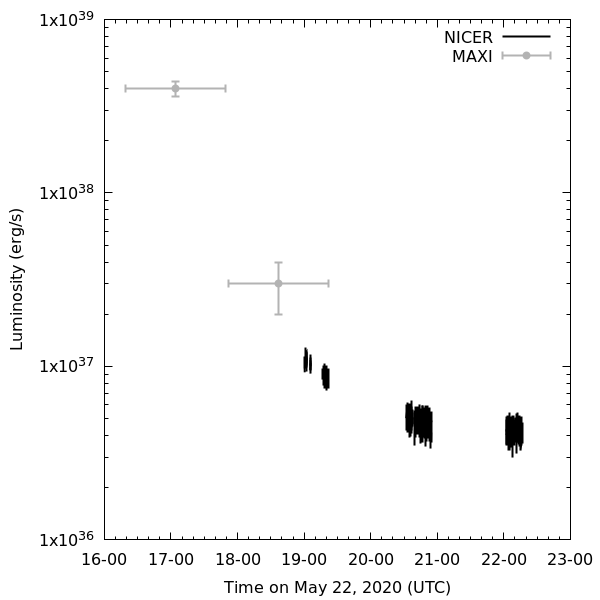NICER / ISS Science Nugget
for May 28, 2020
Recent MAXI alert likely triggered by accreting X-ray binary MAXI J0911-655
On May 22, around 17:00 UTC, a sudden X-ray brightening from the globular cluster NGC 2808
triggered the "nova alert" system of JAXA's MAXI payload. In response, NICER rapidly slewed
to this target and starting observing the known accreting millisecond pulsar MAXI J0911-655,
which was believed to be the source of the emission. Indeed, our observations showed a
neutron star that was several times hotter than MAXI J0911-655 has been historically;
and that it was cooling at an exponential rate.
Between our observations and those collected by MAXI, the origin of this event seems clear:
it was a long-duration X-ray burst, a type of thermonuclear explosion that ignited unusually
deep in the helium layer of a neutron star atmosphere. This ignition depth meant that the burst
had ample fuel and could sustain itself for about 5 hours – many times longer than the
tens of seconds of a regular hydrogen-fueled X-ray burst.
The most probable source of this X-ray burst is MAXI J0911-655. Because it originated in a
globular cluster. However, we cannot rule out the possibility that a second accreting neutron
star became active within the same field of view. Either way, the X-ray burst appears to have
disturbed the accretion flow to the neutron star, as we are still observing substantially
elevated X-ray emission. We will continue to track this source with NICER and other
observatories to determine if indeed MAXI J0911-655 caused this event, and to investigate if
and how the neutron star system settles back into a steady state.

Figure:
Combined light curve of the NICER and MAXI/GSC observations as collected on May 22, 2020.
We will continue to track this source with NICER and other observatories to determine if
indeed MAXI J0911-655 caused this event, and to investigate if and how the neutron
star system settles back into a steady state. The OHMAN (On-orbit Hookup of MAXI and NICER)
effort underway will eventually allow quicker follow up on these types of transient events.
This NICER result is reported in Astronomer's Telegram #13760 by Bult et al.
<< Previous
Main Index
Next >>